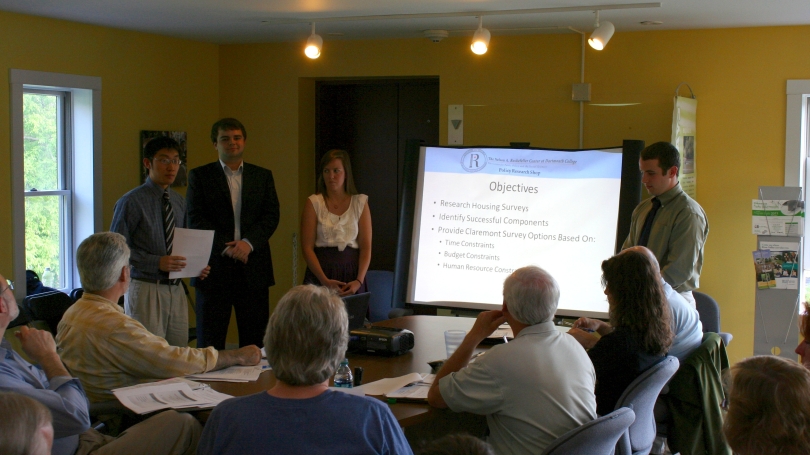
- Public Policy
- Leadership
- Funding
- News & Events
- About the Center
Back to Top Nav
Back to Top Nav
Back to Top Nav
Back to Top Nav
On the evening of May 24, 2011 four Dartmouth students from the Policy Research Shop at the Nelson A. Rockefeller Center traveled to Claremont, New Hampshire to present and discuss their research into methods for conducting an inventory of residential properties in Claremont. Travis Blalock ’12, Kelsey Clark ’11, Austin Major ’14, and Eric Yang ’14 met with Claremont’s “City Center Project” Steering Committee, several town officials, and interested citizens during the monthly meeting of the Steering Committee. The housing stock survey is the first stage in the project which is funded by a grant from the U.S. Department of Housing and Urban Development.
The students discussed survey methodology in general, and other cities’ efforts to inventory housing stock. They provided Claremont officials with a range of options for collecting external and internal information about each property, as well as information about the owners and residents. These options ranged from quick and inexpensive assessments to more detailed methods requiring additional time, money, and expertise. The students’ presentation led to an extended discussion about methods which would best fit Claremont’s goals and constraints.
On May 24, 2011, three Dartmouth student researchers from the Policy Research Shop at the Nelson A. Rockefeller Center traveled to Concord to testify before the Health, Human Services, and Elderly Affairs Committee of the New Hampshire House of Representatives. Catie Burkhard ’11, Karen Doster ’11, and Hope McIntyre ’11, presented their PRS report, “Shared Decision Making: Background Information and Policy Options for New Hampshire,” that describes, summarizes, and analyzes shared decision making in doctor-patient relationships. Shared decision making is a two-way discussion between doctors and patients which informs patients about their options and informs doctors about patients preferences in situations without one clear best course of action. It is a broader and deeper conversation than “informed consent” and appears to lead to increases in patient satisfaction and reductions in procedures. The students described how shared decision making works, summarized the current academic research, and identified implementation challenges. They also described a number of potential policy options comprising varying levels of government involvement which could lead to increased use of shared decision making.